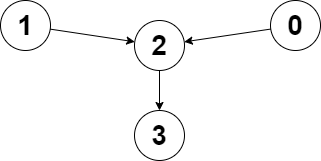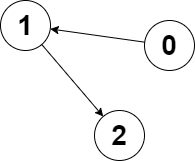2359.Find Closest Node to Given Two Nodes
===
###### tags: `Medium`,`DFS`,`Graph`
[2359. Find Closest Node to Given Two Nodes](https://leetcode.com/problems/find-closest-node-to-given-two-nodes/)
### 題目描述
You are given a **directed** graph of n nodes numbered from `0` to `n - 1`, where each node has **at most one** outgoing edge.
The graph is represented with a given **0-indexed** array `edges` of size `n`, indicating that there is a directed edge from node `i` to node `edges[i]`. If there is no outgoing edge from `i`, then `edges[i] == -1`.
You are also given two integers `node1` and `node2`.
Return *the **index** of the node that can be reached from both* `node1` *and* `node2`, *such that the **maximum** between the distance from* `node1` *to that node, and from* `node2` *to that node is **minimized***. If there are multiple answers, return the node with the **smallest** index, and if no possible answer exists, return `-1`.
Note that `edges` may contain cycles.
### 範例
**Example 1:**

```
Input: edges = [2,2,3,-1], node1 = 0, node2 = 1
Output: 2
Explanation: The distance from node 0 to node 2 is 1, and the distance from node 1 to node 2 is 1.
The maximum of those two distances is 1. It can be proven that we cannot get a node with a smaller maximum distance than 1, so we return node 2.
```
**Example 2:**

```
Input: edges = [1,2,-1], node1 = 0, node2 = 2
Output: 2
Explanation: The distance from node 0 to node 2 is 2, and the distance from node 2 to itself is 0.
The maximum of those two distances is 2. It can be proven that we cannot get a node with a smaller maximum distance than 2, so we return node 2.
```
**Constraints**:
* `n` == `edges.length`
* 2 <= `n` <= 10^5^
* -1 <= `edges[i]` < `n`
* `edges[i]` != `i`
* 0 <= `node1`, `node2` < `n`
### 解答
#### C++
```cpp=
class Solution {
public:
int closestMeetingNode(vector<int>& edges, int node1, int node2) {
int n = edges.size();
vector<int> d1(n, INT_MAX);
int cur = node1, step = 0;
while (cur != -1 && d1[cur] == INT_MAX) {
d1[cur] = step++;
cur = edges[cur];
}
vector<int> d2(n, INT_MAX);
cur = node2;
step = 0;
while (cur != -1 && d2[cur] == INT_MAX) {
d2[cur] = step++;
cur = edges[cur];
}
int ans = -1, upper = INT_MAX;
for (int i = 0; i < n; i++) {
int d = max(d1[i], d2[i]);
if (d < upper) {
upper = d;
ans = i;
}
}
return ans;
}
};
```
> [name=Yen-Chi Chen][time=Wed, Jan 25, 2023]
#### Python
```python=
class Solution:
def closestMeetingNode(self, edges: List[int], node1: int, node2: int) -> int:
node_count = len(edges)
inf = float('INF')
d1 = [inf] * node_count
dist = 0
cur = node1
while (cur != -1 and d1[cur] == inf):
d1[cur] = dist
dist+=1
cur = edges[cur]
d2 = [inf] * node_count
dist = 0
cur = node2
while (cur != -1 and d2[cur] == inf):
d2[cur] = dist
dist+=1
cur = edges[cur]
maxDist = inf
wanted_node = -1
for node in range(node_count):
tempDist = max(d1[node], d2[node])
if tempDist < maxDist:
maxDist = tempDist
wanted_node = node
return wanted_node
```
> [name=Dan][time=Sun, Jan 29, 2023]
```python=
class Solution:
def closestMeetingNode(self, edges: List[int], node1: int, node2: int) -> int:
while (edges[node1] >= 0 or edges[node2] >= 0):
# mark -3 if visited by node1 loop
# mark -2 if visited by node2 loop
if (edges[node1] >= 0):
temp = node1
node1 = edges[node1]
edges[temp] = -3
if (edges[node2] >= 0):
temp = node2
node2 = edges[node2]
edges[temp] = -2
if edges[node1] == -2 and edges[node2] == -3:
return min(node1, node2)
elif edges[node1] == -2:
return node1
elif edges[node2] == -3:
return node2
return -1 if node1!=node2 else node1
```
> [name=Dan][time=Sun, Jan 29, 2023]
### Reference
[回到題目列表](https://hackmd.io/@Marsgoat/leetcode_every_day)